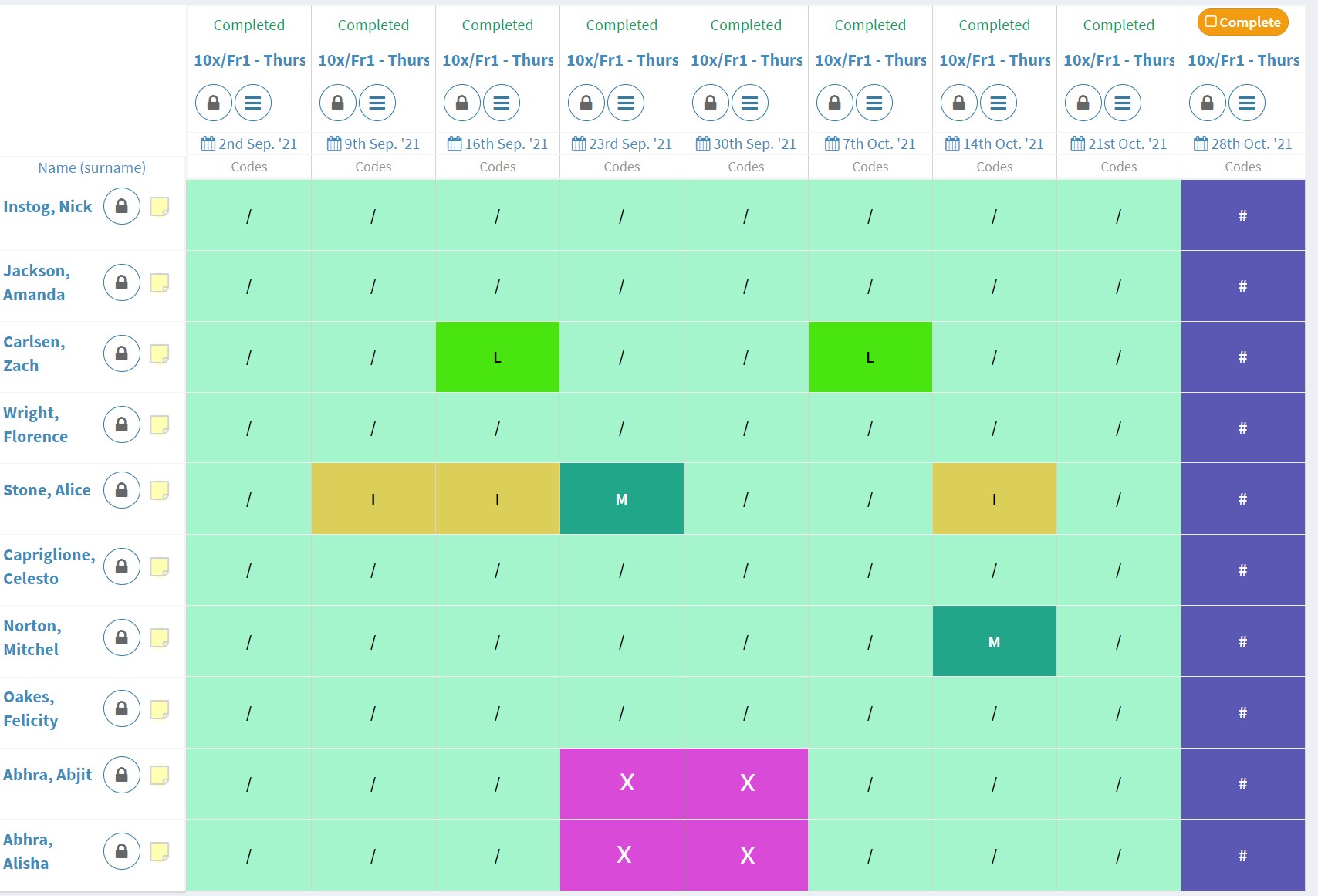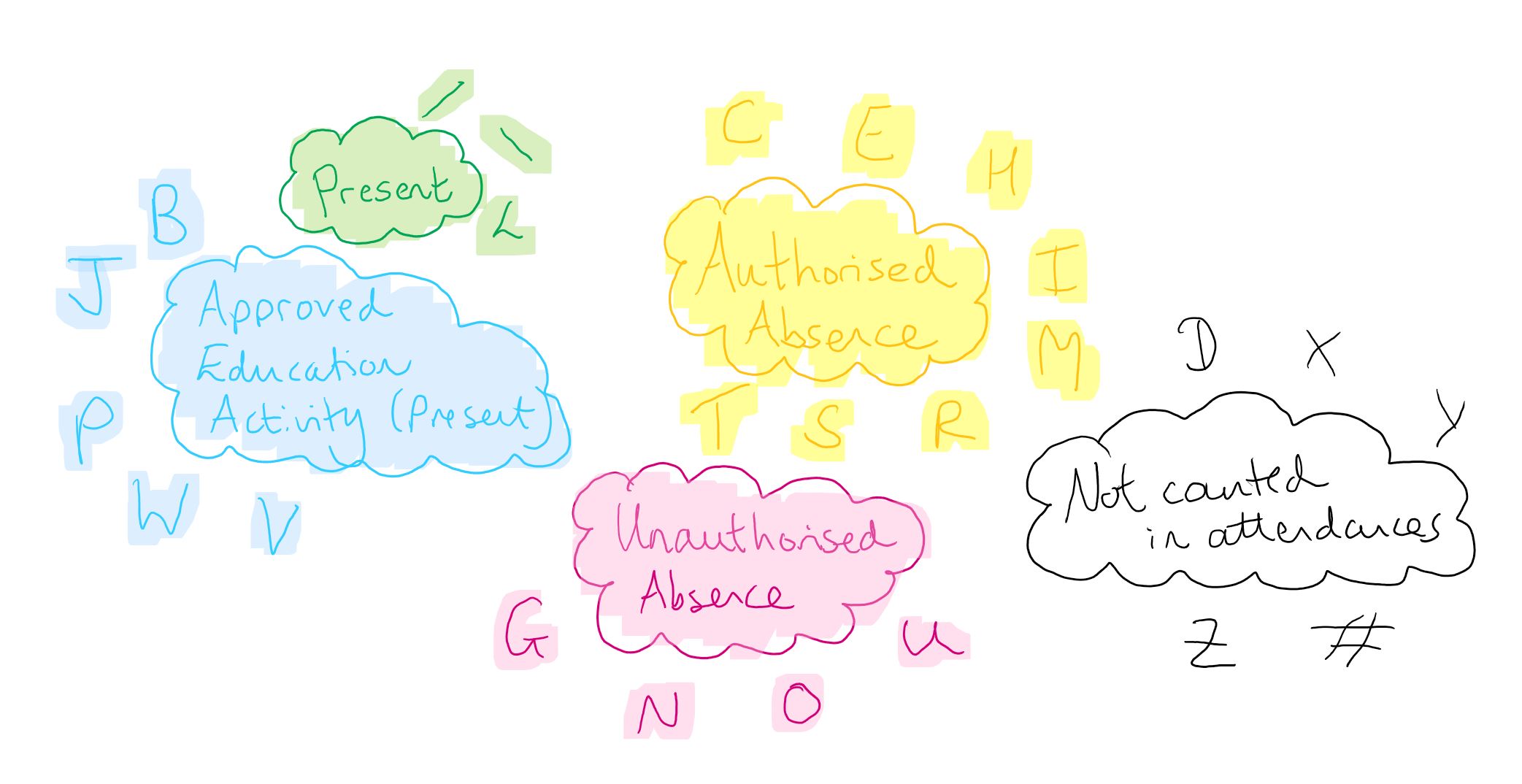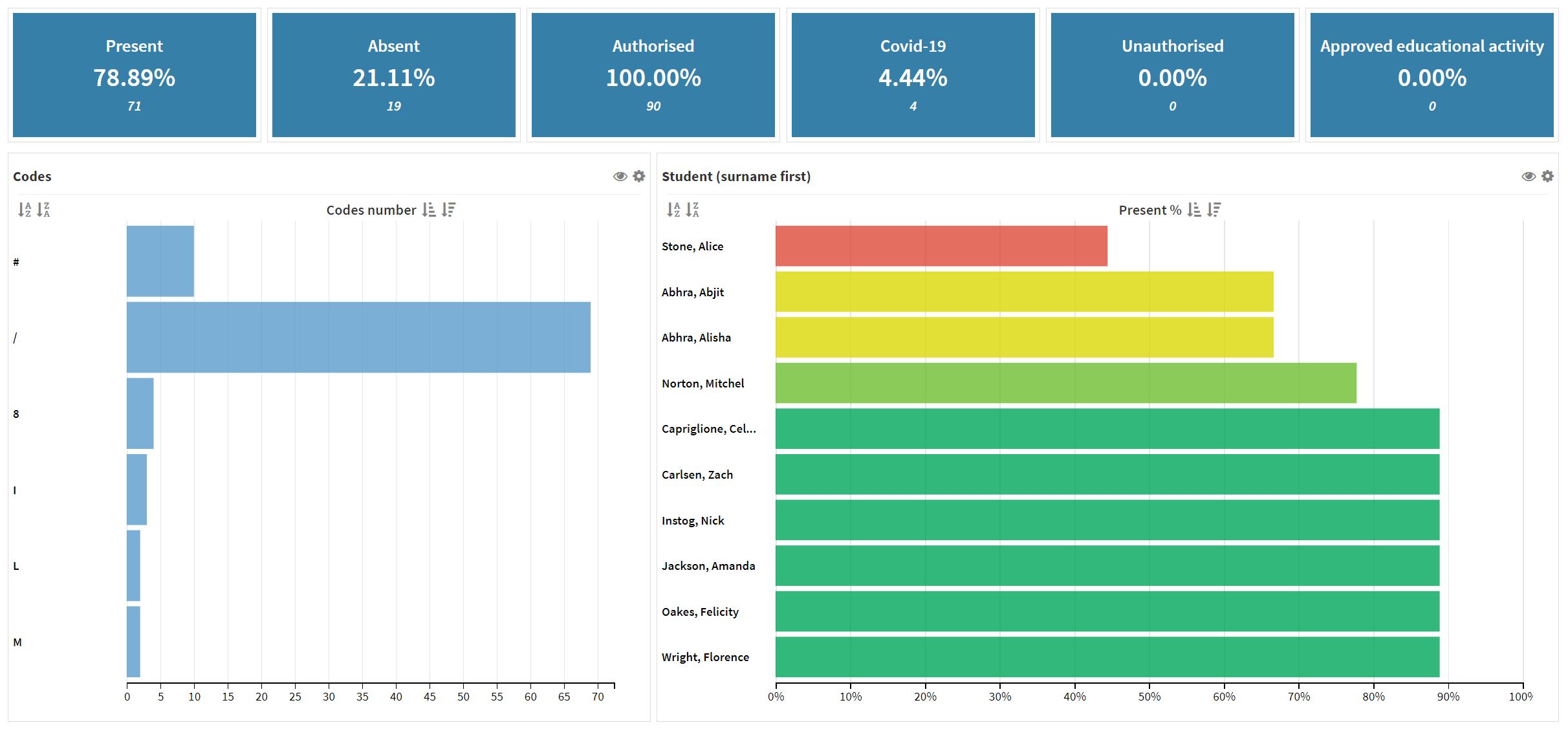The
 blog
blog
The ECT guide to registration codes
4th November 2021 | Sarah CullDuring my 11 years working in education I have taken approximately 3800 am/pm session registrations and entered in the region of 76000 codes into 5 different systems in 4 different schools.
At no point in my teacher training, my NQT year or the 9 years following, did anyone think it was important to teach me about registration codes.
Not that this is intended as a criticism. Early on, in the very limited cases when I needed to branch out beyond /, \, I and M there was someone to ask and then I discovered the government attendance guidance document and read it for myself.
https://www.gov.uk/government/publications/school-attendance

From the bizarre ‘advice’ and dubious assertions I have received from otherwise exceptionally intelligent colleagues over the years surrounding registration codes, I can conclude I’m not the only one who took a while to find the magic piece of alphabet paper.
So here’s my ECT guide to registration codes:
Present
The student is in school, right here, I can see them, they’ve been here since the register opened.
- Fantastic, this is a great start! They are present. Mark them as / or \ depending on whether it is am or pm. (Does anyone remember taking paper registers in a red clipboard to the office at the end of registration??)
Oh no, registration has ended and the student is leaving to go to a medical appointment. I’ve already marked them as present!
- That’s ok. They were present in registration so statistically they are present. This is why we have sign-in and sign-out books in case of fire or emergency. Remind them to sign out and back in again and let them go. This is also a positive argument in favour of lesson registrations to track the impact of attendance on attainment as statistically if they did this every day and made it back for the afternoon session they’d have 100% attendance but have missed a lot of actual learning. A system that does lesson registrations can pick up absence that the school census would miss.
The student was not here when the register started but they’ve sauntered in apologetically 10 minutes after it started because the bus was late.
- Apology or no, they are late, mark them as L. A lot of systems allow you to record minutes late and reasons which are useful for you in monitoring your students and spotting opportunities to help them. Your school may have a policy on punishing persistent absence to discourage it so ask about this if you are unsure.
“Sorry I’m late Miss, I went to Greggs”.
“I left my bag on the bus and it had my train pass in it so then I missed the train while they phoned the bus company and I’m here but I have no bag” “My Mum forgot to drop us off and just drove to work with us in the car”
“The train was late” “I saw your sister 20 minutes ago!” “Yeah ok I actually overslept and she left without me.”
Late excuses can be entertaining, be sure to collect a few to look back on in future.

Approved educational activity
The student is not on site with me but they are involved in an educational activity, will this affect their attendance?
- No. Approved educational activities off-site count as the student being present otherwise yes this would be completely unfair. We use B D J P V and W for these situations. Some of these will not be up to you to use if the whereabouts of the student have not been communicated to you in a timely fashion. Don’t hedge your bets, guess or take the word of the student’s best friend who swears they’re at a hockey match.
It’s also worth noting at this point that schools have different policies on who is responsible for collating information on trips, visits, sporting events etc and it may be that everything comes to you.
Alternatively a central-awesome-admin-hero may be fielding communication from parents and taking phone calls from trips with registration data and will fill in vital information for you.
- B - general off-site educational activity. To use this you need to be confident the student is supervised, the activity is approved and the student is present at the activity. This might be applied in conjunction with someone who has approved the activity so it’s best to be sure before you use it.
- D - this is not, as I was once told, for when your student is in a music lesson during your lesson. Dual registration is for students attending parallel educational establishments, e.g. travellers, PRUs, hospital schools etc. The D you record is if the student is not expected to be with you because they are being registered elsewhere and the D will not count on the school census data.
- J - Interview. For a different school, University, employment etc.
- P - Supervised sporting activity
- V - Educational visit or trip - students should be carefully registered and keep track of on trips and visits and scenarios will vary if they start in school or meet at the site.
- W - present at work experience. Communication needs to be upheld with the place of work experience and absence from the placement should be recorded with absence codes and not just marked as W.
How’s it going? Got all of that so far?
Those are 2 of the 5 overall categories in the school census; present and approved education activity which is also counted as present but recorded separately.

Now we move onto absence - authorised and unauthorised.
I’ve taken the register, the student isn’t here, the session has ended and despite rumours from the other students I have no idea where the student is and have received no communication.
- N - Reason for absence not yet provided. This is not the end of it, you will have to replace this with another code ASAP, certainly before the data is submitted to the school census but ideally within the next hour or so to ensure the safety of the student. Chances are they are running late or their location has not yet been communicated to you.
Authorised absence
The location of the student has been communicated to me - what do I put?
- C - Leave of absence authorised by the school (for use in what the government deems to be exceptional circumstances). I’ve seen this applied for bereavement, funeral attendance, rehearsal and performance time for a student actor and travel necessitated by the parent’s work or family illness where the student took pre prepared work with them to complete.
- This also relates to H - Holiday authorised by the school.
- E - Excluded with no alternative provision
- I - illness, including a positive test for COVID-19. Illness can be authorised at the word of the parent or guardian and does not have to be verified with doctors notes, appointment cards etc unless the school has a reason to question it. (For example the student has been ill for a week and their friends keep receiving Tiktok videos of them in disneyland.)
- M - Medical or dental appointments. Students requiring regular appointments (e.g. orthodontic work) may try to cunningly schedule them over the same lessons that they dislike every time so it is worth keeping a weather eye out for any patterns and communicating gently with parents if you feel it is a problem.
- R - religious observance.
- S - Study leave
- T - Gypsy, Roma and Traveller absence. This code should be used when Traveller families are known to be travelling for occupational purposes and have agreed this with the school but it is not known whether the pupil is attending educational provision.

So what would be unauthorised?
- G - Holiday not authorised - They went on holiday anyway or stayed longer than they were authorised for.
- O - Absent without authorisation - covers any other situations where the reason is not authorised.
- N - back to N for no reason given - Ns should only be used as a placeholder while the absence is investigated and should not remain on the register indefinitely. If no reason is forthcoming, replace them with O.
- U - Arrived in school after registration closed. Worth keeping track of these to see if patterns emerge and resist the urge to go back and replace them with L. They can be replaced with another relevant code, e.g. M, if a reason is found for missing registration.
What about a snow day??
- A snow day would be an example of circumstances which are not counted as possible attendance at all for a student
- # - Planned whole or partial school closure - bank holidays, half terms, INSET days, polling station days etc
- Y - Unable to attend due to exceptional circumstances - flood, snow day, gas leak, local authority travel disruption, national or local emergency etc
- Z - Pupil is not on the admission register - they haven’t started yet but have been added to the MIS for admin purposes.
- X - not required to be in school or not attending in circumstances relating to coronavirus (COVID-19) - used for non-compulsory school aged children and where attendance would conflict with any legislation relating to the transmission of coronavirus, including students with COVID symptoms waiting for test results. If the test comes back positive the code should thereafter be marked as I for illness.
That’s all of them as of November 2021!
Registration codes are important. They’re not glamorous or dramatic or particularly interesting but they are important (and not just because the government requires for registers to be completed accurately and to be reported.) The most important reason to ensure they are accurate is to keep students safe by knowing exactly where they are.
The Department for Education (DfE) published research in 2016 which found that the higher the overall absence rate across Key Stage2 and KS4, the lower the likely level of attainment at the end of KS2 and KS4. Being in school benefits students directly and unless we understand why they aren’t in school, we can’t help because every different reason for absence has a different possible avenue to tackle it.
Your lessons might be the nicest, safest, most enjoyable place to be in the whole world but that won’t improve the attendance of a student with chronic fatigue or the sixth former on the county basketball team.
The data won’t solve the problems for us, but together it can tell a story and sometimes we learn a lot just by trying to collect it.

https://www.gov.uk/government/publications/absence-and-attainment-at-key-stages-2-and-4-2013-to-2014
Other articles you may be interested in
12th October 2021 10 mins
Blog post
15th January 2020 10 mins
Blog post
Data driven schools
Read more3rd December 2019 10 mins
Blog post
Peer to peer grading
Read more23rd October 2019 10 mins
How to
Track SEN cohorts
Read more7th June 2019 10 mins
Blog post
Encouraging marking standardisation
Read more4th April 2019 10 mins
Blog post
Machine learning in education
Read more4th December 2018 10 mins
How to
Creating a seating plan
Read more4th October 2018 10 mins
How to
Auto grade your assessments
Read more1st November 2017 5 mins
Blog post
6 steps to follow to create a good data environment for your school
Read more25th August 2017 10 mins
Blog post